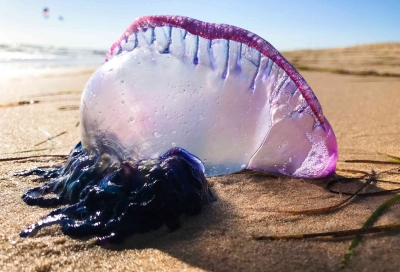
It sounds like a galleon but it is really a very dangerous type of jellyfish! Its poisonous stinging tentacles up to 25 m (82ft) long can sometimes kill humans.
The man-of-war comprises four separate polyps. It gets its name from the uppermost polyp, a gas-filled bladder, or pneumatophore, which sits above the water and somewhat resembles an old warship at full sail. Man-of-wars are also known as bluebottles for the purple-blue color of their pneumatophores.
The tentacles are the man-of-war’s second organism. These long, thin tendrils can extend 165 feet in length below the surface, although 30 feet is more the average. They are covered in venom-filled nematocysts used to paralyze and kill fish and other small creatures. For humans, a man-of-war sting is excruciatingly painful, but rarely deadly. But beware—even dead man-of-wars washed up on shore can deliver a sting.
Muscles in the tentacles draw prey up to a polyp containing the gastrozooids or digestive organisms. A fourth polyp contains the reproductive organisms.
Credit : National Geographic
Picture Credit : Google




